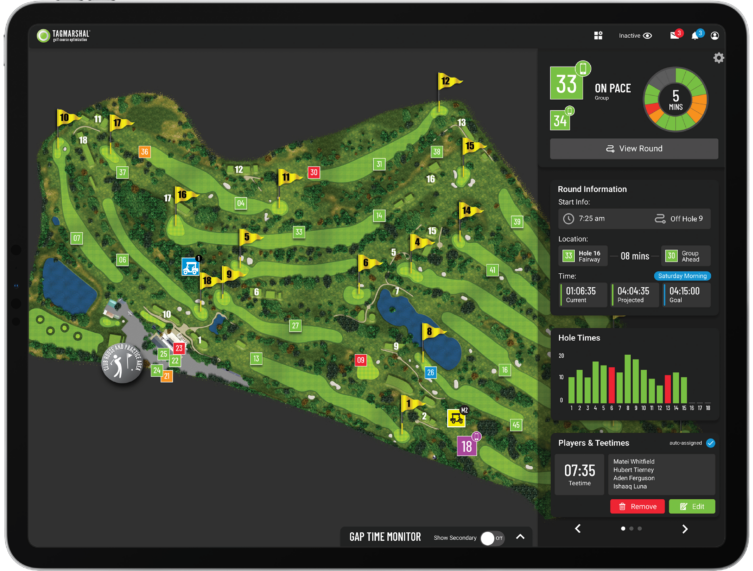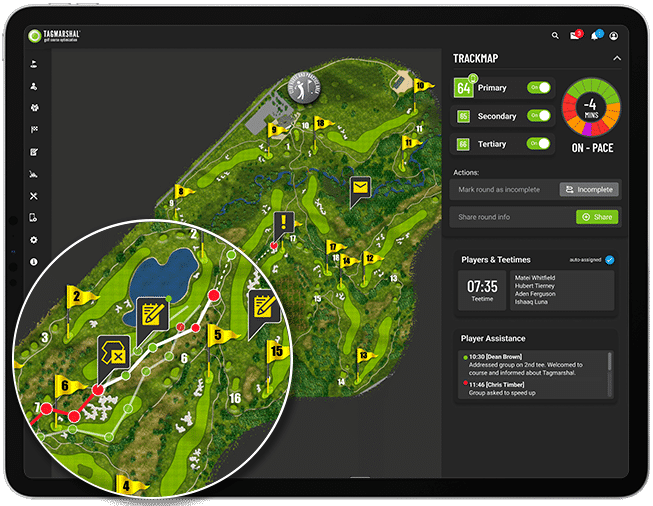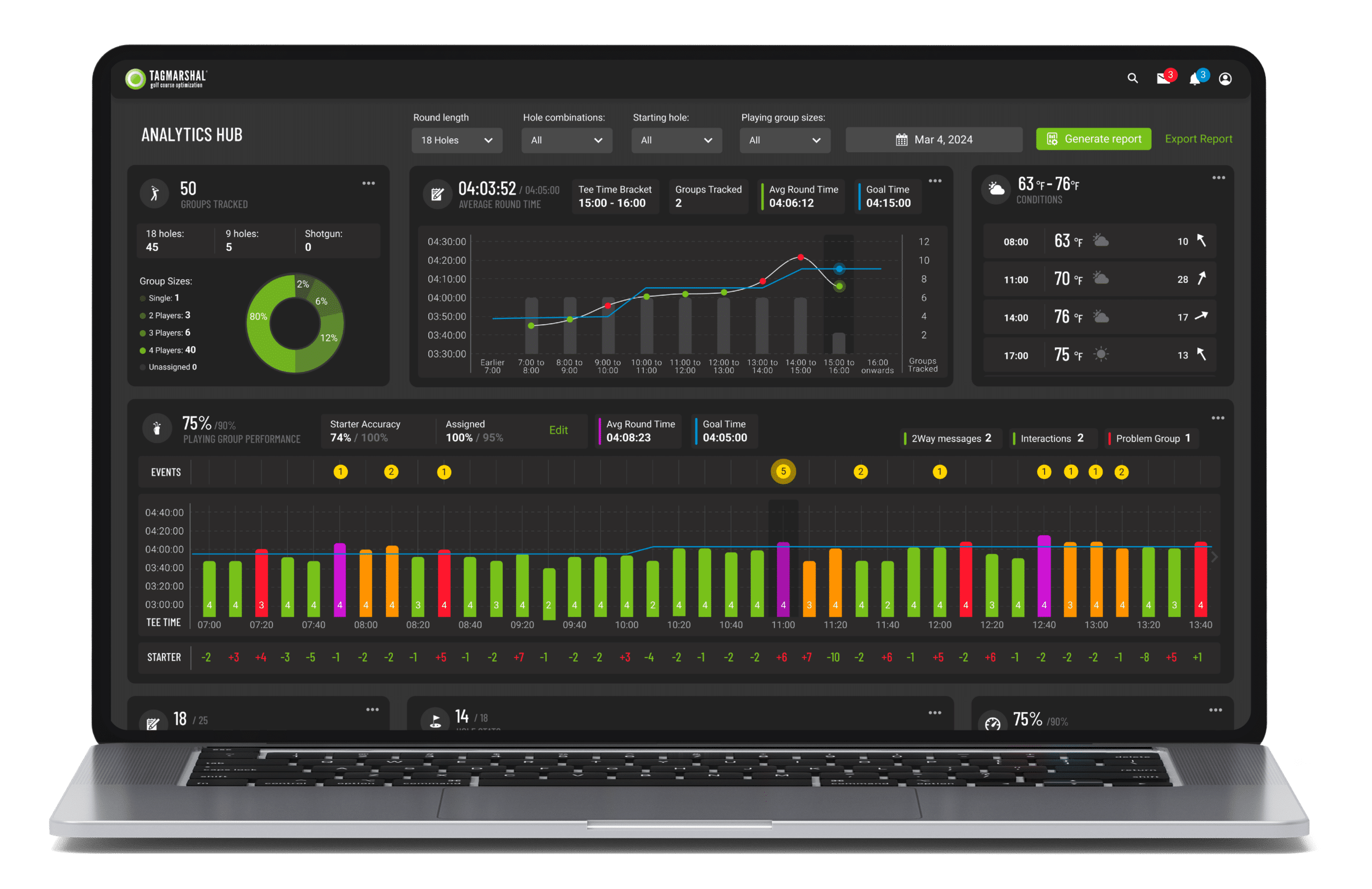A day in the life of a Head Golf Pro: Managing pace and the player experience
A head golf professional’s job, from the moment they arrive at the course in the early morning until they leave after closing the range and pro shop, is a demanding one, both from an operational and player perspective.
To consistently deliver exceptional on-course experiences, while often operating with stretched labor resources and revenue target pressures, courses are increasingly turning to technology for assistance.
Below, we will focus on the challenges head pros face in managing pace and the on-course player experience, and how optimization technology like Tagmarshal helps them achieve their goals.
“I can’t be on the course to identify and manage problem groups”

The most fundamental part of every golf operation, which ultimately underpins whether it’s a success or failure, is ensuring an enjoyable player experience.
More than 75% of golfers strongly agree that pace of play is critical in contributing to one’s enjoyment of a round of golf. A head golf pro must always be available to address pace and flow of play issues as they arise throughout the day, but endlessly patrolling the course and looking for issues isn’t an option.
Using GPS technology that tracks exactly where each playing group is in real-time gives head golf pros oversight from the clubhouse, pro shop, or while on the move. Tagmarshal goes one step further, identifying which groups are delayers and holding up other groups and causing bottlenecks, and which groups are being delayed and out of position through no fault of their own.
The distinction is visible with just a glance at the Live Map screen – delayer groups are purple and delayed groups are orange – so head golf pros can stay on top of pace issues without having to monitor what’s happening on the course constantly.
Equipped with this information, head golf pros or player assistants can then go directly to the problem groups. Addressing the root cause of pace and flow issues, and doing so proactively, minimizes the impact on the rest of the field.
Head golf pros can also set up automated alerts that are sent directly to playing groups that fall a specified time behind pace, reducing the need for in-person check-ins or interactions. These alerts can be sent to staff as well, so that they are constantly kept up to date.
“Players push back when we ask them to get back into position”

Few things ruin a round quicker than being called slow by marshals. USGA research shows that of the 1,000 touchpoints measured during the golfer experience, ‘corrective pace of play actions’ ranks as the touchpoint that most adversely impacts satisfaction, along with ‘speed of others playing on the course.’
Head golf pros and their teams are, therefore, walking a very fine line between effectively managing pace and raising the ire of golfers on the course. When staff have data to rely on, these on-course interactions are entirely reframed.
Instead of being potentially adversarial, they are neutral, fact-based discussions with players able to see why they are being addressed, as well as how the technology being used is there to add value to the on-course experience.
Tagmarshal’s data also allows head golf pros and their teams to identify pace trends. Is a group behind pace because they were very slow on one hole, which could have been due to a lost ball or something similar, or are they consistently trending slower than required across multiple holes? When you can show it’s the latter, it becomes harder for players to push back.
Finally, using the Track Map, head golf pros can engage in constructive post-round conversations with players or members. All interactions and geofence breaches are logged, as well as the round’s entire pace history against the course’s goal time. This is especially useful when responding to complaints that may happen days or even weeks after a round took place.
“I don’t have enough information to formulate and implement a fair pace of play policy”

Pace of play is always a hot topic at any course, be it public or private. The head golf professional is ultimately accountable when things go awry, but getting a handle on pace starts with setting, implementing, communicating, and enforcing a fair and realistic pace of play policy.
Manually gathering a sample size large enough to confidently work out a course’s average round time is extremely labor-intensive, and there is still no guarantee that it will be accurate.
Head golf pros will also be aware that different times of the day play quicker than others, so expecting every group to finish in the same time is unreasonable. Morning rounds traditionally play quicker due to fewer players on the course, with pace slowing mid-morning through to midday. Having one goal time for the entire day fails to take this into account.
Tagmarshal records the exact time every group takes to play down to the second, but it also breaks these pace trends down by key metrics like time of the day and day of the week. This allows head golf pros to gain insight into these nuances and adjust expectations and communication accordingly, so that each playing group is given a realistic goal time.
To keep pace conversations front of mind, head golf pros can give regular, data-driven updates via email or social media, heightening visibility around policies in place and highlighting successes that may attract new golfers looking for a quality experience.
Dealing with board and committee members is also made easier when you have data to rely on that illustrates whether pace of play and other operational goals are being met.
Conclusion
With pace and flow of play so central to the player experience, staying on top of what is happening on the course at all times is a crucial part of a head golf pro’s job.
However, they are faced with two often competing demands. They must plan and execute the day-to-day running of on-course operations, while also being the most public-facing member of the operational team.
Relying on optimization technology for real-time oversight helps juggle both dimensions of the role so that head golf pros deliver results that keep players and management happy.
SEE TAGMARSHAL’S SYSTEM IN ACTION
Watch Demo
ABOUT TAGMARSHAL
Tagmarshal, the market leader in on-course optimization technology, provides courses with full, real-time operational oversight and reporting, giving golf operators the tools to manage pace and flow of play effectively, resulting in enhanced player experiences, increased efficiency through automation, and additional revenue generation.
Tagmarshal’s technology has collected over 100 billion data points from more than 95 million tracked and improved rounds of golf and has relationships with in excess of 900 partners, including Hazeltine, Whistling Straits, Baltusrol, Fieldstone, Bandon Dunes, The Old Course at St Andrews Links, Serenoa and Erin Hills.
Tagmarshal partners with several golf management groups, private, daily fee, public and resort courses, including 50 of the Top 100 courses, as well as many $40-$60 green fee courses, which are seeing excellent results using the system.
 WATCH DEMO
WATCH DEMO